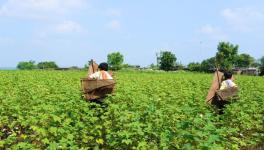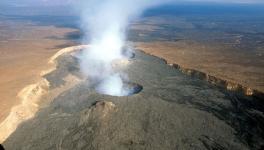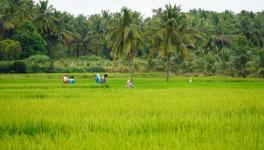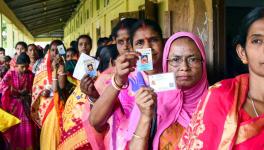Peopling of South Asia and Multiple Migrations from Outside
The genetic evidence shows significant migrations from Eurasian steppes into South Asia. The Indo-Aryan language speakers have a higher signature of Central Asian genes, and even higher for the male population.
Rough Transcript:
Prabir Purkayastha (PP): Hello and welcome to Newsclick. Today, we have with us Dr. Satyajit Rath. Satyajit, we have with us yet another recent paper in evolutionary biology and it seems to flesh out, in much more detail what we have discussed earlier that, there have been multiple migrations into India, we have had Indo- Aryan speakers, language group speakers who seem to have come from outside, it seems to have been a more of a military domination, therefore, difference between matrilineal and patrilineal genetic markers. What do you think is new in this paper?
Satyajit Rath (S.R): So quite frankly, I love this whole trajectory of work and for a number of reasons. One is that rather than providing, simplified, simple-minded answers to our origins it provides increasing complications and nuance and which is how it should be, in my eye.
Secondly, it comes from publicly available data. This particular paper that you are referring to which was published in a journal called BMC evolutionary biology, actually is an analytical approach that does not depend on these people, the investigators, the authors having to go out, collect blood samples, do DNA sequencing and then treat the sequencing data as their data. Instead, they are investigating the comments, the data comments.
They're using methodologies, they are taking advantage of the fact that the data in the comments have grown, that the body of available data in the comments have grown and they are using what appear to be somewhat differently configured analytical investigative approaches to provide, as I said, complicating nuance. What is new is, it begins to provide much greater detail into the story of the peopling of the subcontinent. And three different issues I think are worth highlighting as issues that the paper thrown brings up. One is the notion that humanity expanded out of Africa, as a one-dimensional trajectory over time, which was always in lived experience a nonsensical idea. That made it...
P.P: ...that's not how normal migrations take place...
S.R: That's not how lives are lived over generations and yet, the way it is quite frequently posited is as though we were in exploring species that went forth to some goal, at least of adventure. Instead of simply communities going from here to there, and from there to somewhere else, and then coming back, and going back and forth. Quite remarkably this paper provides genetic footprints of bi-directional migrations.
The second is, a version of the same that it is not as if 60,000 years ago we came from there to here and then no more. That's not how lives would be lived; we would go and not only would we come back but we would go again, and then we would go again, and then we would go again, and over thousands of years, we are talking about thousands of years of traditions. These comings and goings would be in very differently socio-historical context, and the data begin to provide indicators and footprints for multiple migrations each somewhat differently configured enough to allow us dovetail it with archeology, with history - with at least textual history, with linguistics to begin to have a synthesized view of who we are and where we come.
The last point, which inevitably ends up being treated as the most striking point is the clear dichotomy, although I will say that, it is the weakest part of the paper but such as it is the clear dichotomy between matrilineal genetic inheritance and what that shows, and genetic inheritance and patrilineal what that shows, and the discordances thereof. And again, inevitably, the implications of that discordance in terms of patriarchy at one end and of a broader canvass of social history of incursions of communities into the subcontinent at the other end, we can talk more about that. But that's what's new about this paper.
P.P: One part is, the Central Asian footprint seems to be quite clear and that footprint is again not one incursion but a set of migrations that takes place. So that's an interesting directional flow as it were and it seems to also show that the basic of what archeological evidence, linguistic evidence; people have said that essentially Indo-Aryan language speaker came from Cengtral Asia into India and also carried the...shall we say, the Vedic compositions as well as the language. So that seems to be a strikingly corroborated, if you will, by the kind of migration, if you will, of course it does not prove what is the language they spoke but then seems to be quite a strong correlation.
S.R: So, let me complicate that rather than disagree. Let me complicate that. So there is an ancient relatedness between far West Asian Arabian peninsular if you will, genetic influences in South Asia. It’s not there it is not, of course. When you come out of Africa geographical contiguity would make it plausible and indeed; it is in the paper itself, there is some measure of that. But those seem to be older...
P.P: 9,000 years before...
S.R: …there are caveats but those seem to be older. The more recent one, so the more recent ones appear to be mediated by a more indirect route, Anatolia, Iran, central Asia, as in between the seas and down to us that's one issue.
And the second is, and this one is really interesting, they point out that the genetics in order to be properly understood needs to be dissected, if you will, between periodic local expansions of population and incursions of populations of related genes – of related genetic makeup. And their data seem to indicate some degree of success in this deconvolution and what that provides is a snapshot of when the subcontinent had bursts of local expansion and you would think bursts of local expansion of populations would be particularly favorable long-term conditions for population growth.
P.P: All major technological advances like agriculture...
S.R: I'm actually including that in my argument of environmental circumstance climatic alterations but also, as you point out, technological alterations of ... fire, smelting, metal 'a' vs metal 'b' and so on and so forth.
And beginning to see how those periods of expansion and the periods of ingression of community’s match with each will begin to provide a very interesting picture of how in the region, the broader region, there was a population expansion locally that my perhaps have also not just accompanied but may have caused an enabling of between population migrations as well. One can make historically plausible narratives out of this which I'm trying not to do. So that’s one issue, there are expansions like that going very far back, forty thousand years/ forty-five thousand years in the paper is one of the expansions dated, if I'm remembering dates correctly.
P.P: From central India expansion that took place... and the microlith technology, if you will, that’s one of the things that are talked about.
S.R: So the paper is of remarkable interest for this 'landscape of nuance’ as I'm calling it. You're perfectly right the evidence also suggests that over the past three four, five, thousand years, thereabouts, there has been a newer wave of central Asian ingressions. And that newer wave, on the limited data that they have, appears to be far more prominent in paternal lineages than in maternal lineages.
All of this depends on paying attention to what is not mainstream and let me explain that; so, it is not their case that all of our genetics are West Asian or central Asian or anything. They are pointing out that the bulk of genetic inheritance is of course local. Because migrations do not mean en masse replacements of communities, one by the other. They usually mean incursions whether peaceful, violent, strained, amicable, whatever. Incursions over a period of time of small numbers with perhaps disproportionate cultural influences and consequences but in genetic terms, small contributions, particularly given the ever-present reality of patriarchy. The fact that men will have a disproportionate influence, disproportionate to the numbers, on the genetic makeup and equally on cultural makeup. All of this begins to dovetail together in these data.
So that the idea that the 'Aryan Invasion' somehow replaced the pre-existing nonsense is of course arrant nonsense. But on the other, what the small un-regarded minor footprints in our genes tell us about who came from where and how is remarkably interesting. We have to pay attention to the 3%, 5%, 9% components of our genetic landscape in order to appreciate that there is a gradient of West Asian and Central Asian genes in the subcontinent going eastwards... southwards and eastwards and that the relative proportions of the prominence of this small footprint differs radically between maternal and paternal chains.
P.P: Thank you very much Satyajit for being with us. That's all the time we have today, for this episode. Please keep watching Newsclick for further episodes- science, technology, other episodes.
Get the latest reports & analysis with people's perspective on Protests, movements & deep analytical videos, discussions of the current affairs in your Telegram app. Subscribe to NewsClick's Telegram channel & get Real-Time updates on stories, as they get published on our website.
























